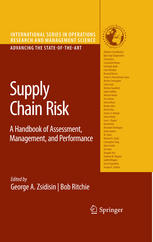

Most ebook files are in PDF format, so you can easily read them using various software such as Foxit Reader or directly on the Google Chrome browser.
Some ebook files are released by publishers in other formats such as .awz, .mobi, .epub, .fb2, etc. You may need to install specific software to read these formats on mobile/PC, such as Calibre.
Please read the tutorial at this link: https://ebookbell.com/faq
We offer FREE conversion to the popular formats you request; however, this may take some time. Therefore, right after payment, please email us, and we will try to provide the service as quickly as possible.
For some exceptional file formats or broken links (if any), please refrain from opening any disputes. Instead, email us first, and we will try to assist within a maximum of 6 hours.
EbookBell Team

4.4
42 reviewsSupply Chain Risk impacts every organization irrespective of sector, size or location in the supply chain. At the same time, the cost of managing supply chain risk is escalating significantly, as are the consequences of not managing such risks effectively. This Handbook represents the work of 30 different authors from 11 different countries, all of whom are recognized international authorities in research, practice, and policy associated with Supply Chain Risk Management (SCRM) and the wider domain of Supply Chain Management (SCM). The first truly comprehensive collection of current research and leading-edge thinking on supply chain risk and its management, the book is structured into four main sections: 1) Risk Analysis, Assessment and Tools; 2) Supply Chain Design and Risk; 3) Supply Chain Risk Management; and 4) Supply Chain Security.
Reflecting the proactive approach SCRM demands, the contributors tackle issues associated with identifying, measuring and classifying risks; designing supply chains to address inherent risks; risk management within the broader Enterprise Risk Management standard; risk in the small and medium-sized sector; disruptive behavior; supply chain security and intentional disruption; continuity planning; and many other topics. Designed to appeal to researchers, scholars, policy makers and practitioners alike, the Handbook is well grounded in robust empirical methodologies and evidence and represents the structures, practices and processes currently employed in industry.